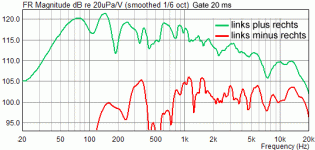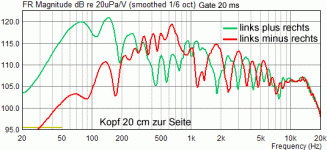I would say directivity up to 200-300 Hz, DR ratio of 10db or more, L-R level matched, and you sitting away from boundaries.
How do you measure D/R ratio? How far away from boundaries? What about early reflections (floor, ceiling)?
dewardh, do you agree or are there additional requirements?
Perhaps you missed this post:
http://www.diyaudio.com/forums/mult...ns-beaten-behringer-what-211.html#post3421813
Note Pano's exceptionally high DR ratio.
I thought this was the most important discussion in that giant thread.
http://www.diyaudio.com/forums/mult...ns-beaten-behringer-what-211.html#post3421813
Note Pano's exceptionally high DR ratio.
I thought this was the most important discussion in that giant thread.
Last edited:
Here's a simple experiment for you . . . hang your tweeters from the ceiling. Set them swinging (side to side) like a pendulum. Get back to us about whether changing the actual source direction has any effect on "imaging".Why is it important that "(the direction of) the real (physical) source (direct plus reflected) remains constant over frequency"?
I would think so. David summarizes it as thus:
"Isn't it interesting that after 100+ pages, now we aren't just talking about the directivity of a speaker. We are seeing that we must consider the combination of listener distance, room liveness, and yes, speaker directivity. But the first two may trump the later and it isn't enough to proclaim that a particular speaker has just the right polar pattern."
To this I would add that speaker directivity is a variable that we have (or I have) more control over. Not everyone can have a large room, sit in the middle, and put up large absorbers at the relevant places. Although, it is probably needed for a good illusion.
Regarding your other questions, I don't have an answer. Not sure about what to do with floor or ceiling reflections.
"Isn't it interesting that after 100+ pages, now we aren't just talking about the directivity of a speaker. We are seeing that we must consider the combination of listener distance, room liveness, and yes, speaker directivity. But the first two may trump the later and it isn't enough to proclaim that a particular speaker has just the right polar pattern."
To this I would add that speaker directivity is a variable that we have (or I have) more control over. Not everyone can have a large room, sit in the middle, and put up large absorbers at the relevant places. Although, it is probably needed for a good illusion.
Regarding your other questions, I don't have an answer. Not sure about what to do with floor or ceiling reflections.
It's been a "problem" ever since we invented living in caves. Fortunately we seem to have evolved an ability to ignore it. Eventually someone will produce an otherwise good sounding line array that lets us hear what reproduction sounds like without it.Not sure about what to do with floor or ceiling reflections.
That will be interesting . . .
dewardh,
If you think about it we always have a floor or ground bounce that we do use for localization and depth. If you could remove that completely wouldn't that be comparable to an anechoic chamber effect? Now we also have to consider that the recording microphone would also pick up the floor bounce and you could say we are adding the bounce twice in that instance. Isn't the whole point of the curved line array going all the way to the floor the elimination of the floor bounce due to the proximity of the bottom speakers to the floor itself with little to no distance?
If you think about it we always have a floor or ground bounce that we do use for localization and depth. If you could remove that completely wouldn't that be comparable to an anechoic chamber effect? Now we also have to consider that the recording microphone would also pick up the floor bounce and you could say we are adding the bounce twice in that instance. Isn't the whole point of the curved line array going all the way to the floor the elimination of the floor bounce due to the proximity of the bottom speakers to the floor itself with little to no distance?
Here's a simple experiment for you . . . hang your tweeters from the ceiling. Set them swinging (side to side) like a pendulum. Get back to us about whether changing the actual source direction has any effect on "imaging".
How is that related to anything we have discussed the last few pages? Running out of arguments to defend your beliefs?
I asked some simple and precise questions but you avoid answering them. Why is that?
To make things easier for you, do you believe that the perceived position of a virtual source formed by a uniformly radiating speaker is the simple average of all its mirror sources?
Last edited:
Markus,
In your last question wouldn't that have a lot to do with the actual dimensions of the triangular relationship of the different path lengths? If you had an equilateral triangle with all dimensions being equal back to the listening position that would seem like it would have the maximum and most coherent reflective source vs multiple path lengths.
In your last question wouldn't that have a lot to do with the actual dimensions of the triangular relationship of the different path lengths? If you had an equilateral triangle with all dimensions being equal back to the listening position that would seem like it would have the maximum and most coherent reflective source vs multiple path lengths.
Certainly NOT with Davids method. That is good for looking at room and stereo placement symmetry, but that's it:How do you measure D/R ratio?

Above is the optimal result in my listening situation.
And this is with the mikrophone moved 20 cm to the side:

As far as you can get. The only good boundary is the wall between your left and right ear.How far away from boundaries?
Markus, it's hard to understand what you are arguing for or against, because it appears that you argue against anything that is posted. It is ok to not reach any conclusions because there isn't enough data, but then state that clearly. Nobody here has all the answers.
Did you do the DR ratio test? Did you tell us what were the speakers that you listened to that had directivity control down low? Do you have an answer to the floor/ceiling question? Do you even have a hypothesis about what could be done to fix them? Did you listen to Pano's files? If yes, did you tell us what you experienced?
Did you do the DR ratio test? Did you tell us what were the speakers that you listened to that had directivity control down low? Do you have an answer to the floor/ceiling question? Do you even have a hypothesis about what could be done to fix them? Did you listen to Pano's files? If yes, did you tell us what you experienced?
Certainly NOT with Davids method. That is good for looking at room and stereo placement symmetry, but that's it
It takes a bit of effort to get the cancellation even through the spectrum. The time lock feature in Holm is useful.
There is something unsymmetrical in your setup. Once you get proper cancellation, the important result is to see is how far below the direct sound is the reverberant field. With highly directional speakers and a moderately damped room, the reverberant field will be 10db or more lower than direct sound -- a good condition for the stereo illusion.
No.do you believe that the perceived position of a virtual source formed by a uniformly radiating speaker is the simple average of all its mirror sources?
Do you believe that a source that varies in direction with frequency can produce a stable stereo "image" ? ? ? That is what happens with a non-uniform polar response in a small room . . .
To make things easier for you, do you believe that the perceived position of a virtual source formed by a uniformly radiating speaker is the simple average of all its mirror sources?
No, the Haas effect will suppress the mirror sources and the direct sound will determine the perceived position, even if less loud than the reflections. The mathematical truth is not what the brain perceives.
and that is a survival thing.. Imagine the reflection same level, or even slightly higher than direct sound.. You surely did not want the reflexion to be interpreted as the saber toothed tiger, in these gold old cave days.. because yes, if we take our primates cousins into consideration, we have lived in caves for something like..50 millions of years?
Is there a study on primate hearing/localization capacity? Just out of curiosity, for fun..
Is there a study on primate hearing/localization capacity? Just out of curiosity, for fun..
Last edited:
I'd love to see evidence of the use of floor bounce for either localization or "depth" perception.If you think about it we always have a floor or ground bounce that we do use for localization and depth.
There is a covered walkway by the music building at UCB which produces a very weird effect if you walk under it while talking . . . the change in "sound" is dramatic. You absolutely know that something has changed about the acoustic space. But it's not a "localization" effect . . .
There should be no even cancellation through the spectrum for constant directivity sources. Cancellation should be weaker for higher frequencies.It takes a bit of effort to get the cancellation even through the spectrum.
Rudolf
OK, you do NOT believe that the perceived position of a virtual source formed by a uniformly radiating speaker is the simple average of all its mirror sources.
So why do you believe a speaker that radiates uniformly would generally create a source that does NOT vary in direction?
You can't have both.
Nobody here has all the answers.
Oh, tell that Mr. dewardh.
Did you do the DR ratio test?
Yes, see the other thread.
That both is and isn't what actually happens. In one of my first (posted) comments after hearing the LX521 at BurningAmp (where there was a highly reflective concrete wall behind the speakers) I remarked on the effect of moving around the speaker into the "null". The "phantom center" image remained surprisingly stable as I moved from center to the side, and then "snapped" suddenly to behind the speakers (between them and the wall) as I moved into the null. A "new" image appeared, formed by the wall reflections. It startled me the first time it happened (I was listening for the "null" frequency response, not the "imaging", which had already impressed me). I was surprised to find that the effect was consistently reproducible. The experience substantially enhanced my appreciation for the impact of reflections on "localization".No, the Haas effect will suppress the mirror sources and the direct sound will determine the perceived position, even if less loud than the reflections.
- Home
- Loudspeakers
- Multi-Way
- Linkwitz Orions beaten by Behringer.... what!!?